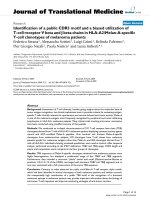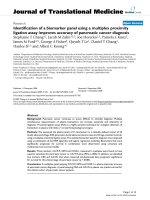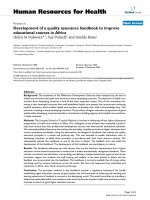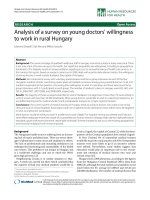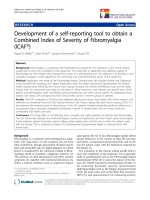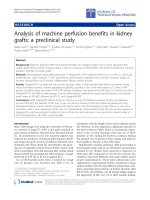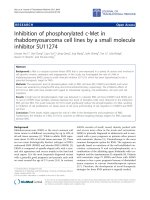Báo cáo sinh học: " Identification of a truncated nucleoprotein in avian metapneumovirus-infected cells encoded by a second AUG, in-frame to the full-length gene" potx
Bạn đang xem bản rút gọn của tài liệu. Xem và tải ngay bản đầy đủ của tài liệu tại đây (520.12 KB, 9 trang )
BioMed Central
Page 1 of 9
(page number not for citation purposes)
Virology Journal
Open Access
Research
Identification of a truncated nucleoprotein in avian
metapneumovirus-infected cells encoded by a second AUG,
in-frame to the full-length gene
Rene Alvarez
1,2
and Bruce S Seal*
1,3
Address:
1
Southeast Poultry Research Laboratory, Agricultural Research Service, U.S. Department of Agriculture, Athens, GA 30605, USA,
2
Present
address: Department of Infectious Diseases, College of Veterinary Medicine, University of Georgia, Athens, GA 30605, USA and
3
Poultry
Microbiological Safety Research Unit, ARS, USDA, 950 College Station Rd., Athens, GA 30605, USA
Email: Rene Alvarez - ; Bruce S Seal* -
* Corresponding author
Abstract
Background: Avian metapneumoviruses (aMPV) cause an upper respiratory disease with low
mortality, but high morbidity primarily in commercial turkeys. There are three types of aMPV (A,
B, C) of which the C type is found only in the United States. Viruses related to aMPV include human,
bovine, ovine, and caprine respiratory syncytial viruses and pneumonia virus of mice, as well as the
recently identified human metapneumovirus (hMPV). The aMPV and hMPV have become the type
viruses of a new genus within the Metapneumovirus. The aMPV nucleoprotein (N) amino acid
sequences of serotypes A, B, and C were aligned for comparative analysis. Based on predicted
antigenicity of consensus protein sequences, five aMPV-specific N peptides were synthesized for
development of peptide-antigens and antisera.
Results: The presence of two aMPV nucleoprotein (N) gene encoded polypeptides was detected
in aMPV/C/US/Co and aMPV/A/UK/3b infected Vero cells. Nucleoprotein 1 (N1) encoded from the
first open reading frame (ORF) was predicted to be 394 amino acids in length for aMPV/C/US/Co
and 391 amino acids in length for aMPV/A/UK/3b with approximate molecular weights of 43.3
kilodaltons and 42.7 kilodaltons, respectively. Nucleoprotein 2 (N2) was hypothesized to be
encoded by a second downstream ORF in-frame with ORF1 and encoded a protein predicted to
contain 328 amino acids for aMPV/C/US/Co or 259 amino acids for aMPV/A/UK/3b with
approximate molecular weights of 36 kilodaltons and 28.3 kilodaltons, respectively. Peptide
antibodies to the N-terminal and C-terminal portions of the aMPV N protein confirmed presence
of these products in both aMPV/C/US/Co- and aMPV/A/UK/3b-infected Vero cells. N1 and N2 for
aMPV/C/US/Co ORFs were molecularly cloned and expressed in Vero cells utilizing eukaryotic
expression vectors to confirm identity of the aMPV encoded proteins.
Conclusion: This is the first reported identification of potential, accessory in-frame N2 ORF gene
products among members of the Paramyxoviridae. Genomic sequence analyses of related members
of the Pneumovirinae other than aMPV, including human respiratory syncytial virus and bovine
respiratory syncytial virus demonstrated the presence of this second potential ORF among these
agents.
Published: 12 April 2005
Virology Journal 2005, 2:31 doi:10.1186/1743-422X-2-31
Received: 04 April 2005
Accepted: 12 April 2005
This article is available from: />© 2005 Alvarez and Seal; licensee BioMed Central Ltd.
This is an Open Access article distributed under the terms of the Creative Commons Attribution License ( />),
which permits unrestricted use, distribution, and reproduction in any medium, provided the original work is properly cited.
Virology Journal 2005, 2:31 />Page 2 of 9
(page number not for citation purposes)
Background
Avian metapneumovirus (aMPV) causes turkey rhinotra-
cheitis (TRT) and is associated with swollen head syn-
drome (SHS) of chickens that is usually accompanied by
secondary bacterial infections which can increase morbid-
ity and induce mortality. Avian metpnuemovirus was first
reported in South Africa during the early 1970s and was
subsequently isolated in Europe, Israel and Asia [1,2].
During 1997, mortality due to aMPV infections among
commercial turkeys in the U.S. ranged from zero, to 30%
when accompanied by bacterial infections, with condem-
nations due to air sacculitis. This was the first reported
outbreak of aMPV infections in the U.S. which was previ-
ously considered exotic to North America. The virus caus-
ing disease was designated a new aMPV type C genetically
different from European counterparts [3-5] and was sub-
sequently demonstrated to be most closely related to
human metapneumovirus (hMPV) from diverse geo-
graphic locations [6,7]. Infections among commercial tur-
keys with aMPV/C continue in the north-central U.S.
resulting in substantial economic loss to the poultry
industry [6,8,9].
Pneumoviruses are members of the family Paramyxoviri-
dae that contain a nonsegmented, negative-sense RNA
genome of approximately 15 kb in length. Viruses related
to aMPV include human, bovine, ovine and caprine respi-
ratory syncytial viruses and pneumonia virus of mice [10],
as well as the recently identified hMPV [11]. Although
genome length is similar, pneumoviruses generally
encode ten genes, compared to six or seven in other para-
myxoviruses. These include the nonstructural proteins
(NS1 and NS2), nucleoprotein (N), phosphoprotein (P),
matrix protein (M), small hydrophobic protein (SH), sur-
face glycoprotein (G), fusion protein (F), second matrix
protein (M2) and a viral RNA-dependent RNA polymerase
(L). The pneumoviruses have an F protein that promotes
cell fusion, but these viruses do not hemagglutinate, nor
do they have neuraminidase activity in their G attachment
protein. This is an important distinguishing characteristic
from the other paramyxoviruses [10].
Because of a limited genome size, many non-segmented
RNA viruses, including the pneumoviruses, have devised
mechanism to increase protein coding capacities. This
may occur at two levels: 1) transcriptional mRNA process-
ing or modification [12-14] or 2) translational, in which
proteins may be produced from alternative open reading
frames (ORFs) or from translational initiation at non-
AUG or downstream AUG codons [15-17]. Among the
pneumoviruses, secondary coding usage has only been
documented for the M2 gene, which encodes two pro-
teins. The M2-1, a transcription antitermination factor, is
required for processive RNA synthesis and transcription
read-through at gene junctions. The M2-2 is involved with
the shift between viral RNA transcription and replication
[18]. In this report, we present evidence for utilization of
a secondary open reading frame, within the N gene encod-
ing a truncated nucleoprotein (N2) among aMPV/C/Co
and aMPV/A/UK/3b infected cells.
Results
Avian metapneumovirus N gene possess several putative
AUG start sites
The aMPV/C/US/Co nucleoprotein is encoded by the N
gene with a predicted molecular weight of 42–45 kD
[7,19]. The N gene ranges from 1191 to 1206 nucleotides
in length [6,19], with the first AUG at nucleotide position
14 (Fig. 1) in all three subtypes (A, B, and C). The aMPV/
C/US/Co N gene has additional putative start sites at
nucleotide positions 212, 350, 416, 758, 785, 827, 896,
and 1022 with "true" Kozak sequences [20] at nucleotide
positions 413 (ACCAUG
G) and 893 (GAGAUGG), with
predicted translation products of 28.5 kD and 10.78 kD,
respectively. The aMPV/A/UK/3b N gene has additional
putative start sites at nucleotide positions 161, 212, 293,
410, 413, 605, 722, 749, 749, 776, 818, 887, and 1013
with "true" Kozak sequences [20] at nucleotide positions
602 (AGGAUG
G), 719 (AGGAUGG), and 884
(AAAAUG
G), with predicted translation products of
21.26 kD, 16.73 kD, and 10.54 kD, respectively.
Avian metapneumovirus-infected cells produce two
proteins (N1 and N2) encoded by two open-reading frames
within the N gene
Five peptides within the aMPV N gene (Fig. 2) were uti-
lized to generate affinity-purified rabbit peptide antibod-
ies. This approach was exploited to determine if any of the
alternative start sites of the aMPV N gene were utilized
during an active cell infection. aMPV/N-peptide antibody
directed against aMPV/C/US/Co N protein amino acids
10–29 (DLSYKHAILKESQYTIKRDV) with only 3 changes
in both aMPV types A and B at amino acid positions 12 (S
to E), 19 (K to D) and 26 (K to R) reacted with all three
full length nucleoproteins by western blot (Fig. 3A, Lanes
3, 4, and 5), but did not react with any proteins in unin-
fected Vero cells (Fig. 3A, Lane 2). All three virus nucleo-
proteins were between 42–45 kD based on SDS-PAGE/
western blot analysis (Fig. 3A). We then tested the aMPV/
C-N2 peptide antibody directed against amino acids 128–
148 in the mid-portion of the of the aMPV/C/US/Co iso-
late (Fig. 2) by western blot which would recognize any
downstream translation products encoded by the N gene
and utilization of any secondary start sites. Western blot
analysis revealed two putative N gene products in aMPV/
C/US/Co-infected Vero cells, the first, the full-length
nucleoprotein with a molecular weight of approximately
43 kD (Fig. 3B, Lane 3) and the second, a smaller protein
of approximately 35–36 kD (Fig. 3B, Lane 3). The peptide
antibody to amino acids 303 to 393 (aMPV/C-N4)
Virology Journal 2005, 2:31 />Page 3 of 9
(page number not for citation purposes)
synthesized to be reactive to the C-terminal N protein
from aMPV/C also recognized two proteins as in Fig. 3B,
Lane 3 (data not shown).
To evaluate whether the utilization of alternative start sites
was unique to members of the aMPV type C group, or
whether this also occurred in other aMPV types, we uti-
lized aMPV/A-N3 and aMPV/A-N5 peptide antibodies
(anti-aMPV/Type A, N protein, amino acids 126–145 and
380–390, respectively). Unlike aMPV/C-N2 peptide anti-
body, aMPV/A-N3-peptide antibody (amino acids 126–
145) reacted to only a full length nucleoprotein (Fig. 3C,
lane 3) similar to the aMPV/N-peptide antibody (Fig. 3C,
lane 2), while aMPV/A-N5-peptide antibody (amino acids
380–390) reacted with both the full length nucleoprotein
of approximately 41–43 kD (Fig. 3C, lane 4) and a smaller
protein of approximately 28–30 kD (Fig. 3C, lane 4).
Finally, all aMPV type-specific antibodies were not cross
active with other metapneumoviruses (data not shown).
Expression of the N1 and N2 ORF of avian
metapneumovirus type C/Colorado in eukaryotic cells
Sequence analysis of the aMPV/C/US/Co and aMPV/A/
UK/3b N gene nucleotide sequences revealed that down-
stream of the first AUG (position 14) were multiple puta-
tive start sites as described above (Fig. 1). We therefore
utilized sequence analysis software to analyze the N gene
putative open reading frames and the predicted transla-
tion products from each putative start site for products
that would result in proteins of approximate size as the
smaller reactive band that was detected by western blot
(Fig. 3B, lane 3 and Fig. 3C, lane 4). Two predicted pro-
teins in the aMPV/C/US/Co sequences corresponding to a
predicted molecular weight of approximately 31.12 kD
Alignment of avian metapneumovirus type A and C nucleoprotein genes demonstrating presence of multiple start sitesFigure 1
Alignment of avian metapneumovirus type A and C nucleoprotein genes demonstrating presence of multiple start sites. Under-
lined sequences denote hypothesized alternative in-frame start sites and the stop codon. Primer sequences utilized for cDNA
synthesis of nucleoprotein genes are also illustrated.
N1 ______________________________
aMPV/C/US/Co GGGACAAGTG AAAATGTCTC TTCAGGGGAT TCAGCTTAGT GACTTGTCCT ATAAGCATGC AATCCTTAAA GAATCACAGT ACACAATCAA 90
aMPV/A/UK/3b GGGACAAGTC AAAATGTCTC TTGAAAGTAT TAGACTCAGT GACTTGGAGT ACAAACATGC AATTCTTGAA GACTCTCAGT ATACAATTAG 90
aMPV/C/US/Co AAGAGATGTG GGGACAACCA CAGCTGTCAC TCCGTCTTCT CTGCAGAGGG AAGTGTCACT CTTATGTGGA GAGATACTGT ATGCCAAGCA 180
aMPV/A/UK/3b AAGGGATGTT GGTGCTACCA CTGCGATCAC ACCTTCCGAA CTGCAGCCGC AAGTATCCAC ATTATGCGGT ATGGTGTTGT TTGCAAAACA 180
N212 ____________________
aMPV/C/US/Co CACAGATTAC TCACATGCAG CTGAAGTAGG AATGCAGTAC GTGAGCACCA CACTGGGAGC AGAGCGTACA CAGCAGATAC TAAAGAACTC 270
aMPV/A/UK/3b CACCGACTAT GAGCCTGCAG CAGAGGTAGG CATGCAGTAC ATTAGTACTG CTCTAGGAGC TGATAGAACT CAACAAATAC TGAAAAATTC 270
aMPV/C/US/Co AGGTAGTGAG GTGCAGGCAG TATTGACCAA GACA TACT CTCTTGG-GA AGGGCAAAAA CAGCAAAGGG GAGGAGTTGC AAATGTTAGA 357
aMPV/A/UK/3b CGGTAGTGAA GTACAGGGTG TTATGACCAA GATTGTTACA CTTTCGGCAG AGGGTTCTGT CAGAAAGCGA GAGGTGCT AAACATTCAC 358
aMPV/C/US/Co CATACATGGG GTTGAAAGAA GT TGG-AT TGAAGAAGTT GACAAAGAGG CAAGGAAAAC CATGGCCTCA GCTACAAAGG ACAACTCAGG 444
aMPV/A/UK/3b GATGTA-GGT GTTGGGTGGG CTGATGATGT CGAAAGGACT ACAAGAGAAG CAATGGGAGC AATGG TTA GGGAAAAAGT GCAACTCA 443
aMPV/C/US/Co ACCAATACCA CAAAATCAAA GACCATCATC CCCGGATGCT CCTATCATAC TACTCTGCAT AGGAGCATTA ATCTTCACGA AGCTGGCATC 534
aMPV/A/UK/3b CAA -AGAATCAAA AGCCGTCTGC CTTGGATGCT CCCGTTATTC TATTATGCAT TGGTGCCCTC ATTTTCACCA AGTTGGCCTC 525
aMPV/C/US/Co AACAATCGAA GTTGGGCTGG AGACAGCTGT TAGAAGGGCA AACCGTGTGC TGAATGATGC ATTGAAAAGG TTCCCAAGGA TTGACATCCC 624
aMPV/A/UK/3b AACTGTTGAA GTAGGCCTTG AAACTGCTAT CCGGCGTGCC TCAAGGGTAT TAAGCGATGC CATATCACGG TACCCCAGGA TGGACATACC 615
aMPV/C/US/Co CAAAATTGCG AGGTCCTTTT ATGATCTGTT TGAGCAGAAA GTTTACTACA GGAGCTTGTT TATAGAGTAT GGCAAAGCCC TTGGGTCTTC 714
aMPV/A/UK/3b AAGGATTGCC AAATCATTCT TTGAATTGTT TGAGAAGAAG GTGTATTACA GAAATCTATT TATTGAATAC GGTAAGGCAC TCGGAAGTAC 705
aMPV/C/US/Co TTCCACAGGA AGCAAGGCAG AAAGCCTGTT TGTGAATATT TTCATGCAAG CTTATGGTGC AGGTCAGACA ATGCTAAGAT GGGGGGTAAT 804
aMPV/A/UK/3b ATCCACCGGA AGCAGGATGG AGAGCCTGTT TGTGAATATT TTTATGCAAG CTTATGGGGC AGGGCAAACA ATGCTGCGCT GGGGTGTCAT 795
aMPV/C/US/Co TGCCAGATCA TCCAACAATA TAATGTTGGG CCATGTCTCC GTACAAGCAG AACTCAAACA GGTTACGGAG GTATATGATC TAGTTAGAGA 894
aMPV/A/UK/3b TGCACGATCC TCCAACAATA TAATGTTGGG CCATGTATCT GTCCAAGCTG AGTTGAGGCA AGTATCTGAG GTCTATGACC TAGTGAGGAA 885
aMPV/C/US/Co GATGGGCCCT GAGTCAGGTC TTCTTCACCT GAGGCAAAAC CCTAAGGCAG GGTTGTTGTC ACTTGCCAAT TGTCCCAATT TTGCAAGTGT 984
aMPV/A/UK/3b AATGGGACCT GAGTCAGGGT TACTACACTT ACGCCAGAGT CCCAAAGCGG GTCTTTTATC ATTGACCAAC TGTCCCAATT TTGCCAGTGT 975
aMPV/C/US/Co GGTGCTAGGG AATGCCTCAG GATTGGGGAT ACTTGGTATG TACAGAGGAA GAGTACCAAA TACAGAGCTA TTTGCCGCAG CAGAAAGCTA 1074
aMPV/A/UK/3b TGTCCTCGGG AACGCCGCCG GGCTTGGTAT TATAGGCATG TACAAAGGTC GAGCCCCCAA CCTTGAGCTG TTTGCTGCTG CTGAAAGTTA 1065
aMPV/C/US/Co TGCAAGAAGC CTAAAAGAAA GCAATAAGAT AAATTTCTCA TCTCTTGGTC TGACAGAAGA GGAAAAAGAA GCTGCTGAGA ACTTTCTCAA 1164
aMPV/A/UK/3b TGCACGGACA TTGAGAGAGA ACAACAAGAT CAACCTAGCG GCCTTAGGGC TCACTGATGA TGAGAGGGAA GCAGC-AACA TCCTACCTAG 1154
_____________________________________ N1185c
aMPV/C/US/Co CATAA-ATGA -GGAAGGCCA GAATGATTAT GAGTAATTAA AAAA 1206
aMPV/A/UK/3b GGGGAGATGA TGAGAGATCA TCCAAATT-T GAGTAATTAA AAAA 1197
Virology Journal 2005, 2:31 />Page 4 of 9
(page number not for citation purposes)
(third AUG) and another at 28.5 kD (fourth AUG) were
detected in the N gene sequence.
Since SDS-PAGE analysis is not necessarily an accurate
measurement of molecular size, both starts sites could
result in a protein observed at approximately 35–36 kD by
SDS-PAGE, and therefore either site could result in the
second ORF product. We therefore used two primer sets
N1/N1189C and N212/N1189C which spans either the
full length of ORF1 or the ORF2 and any down stream
putative ORFs of aMPV/C/US/Co, respectively (Fig. 2) to
amplify both ORFs by RT-PCR. Both ORFs were amplified
and cloned into a eukaryotic expression vector. Western
blot analysis of the Vero cell expressed N1 and N2 ORFs
revealed one reactive band in the pCR3.1-N1ORF trans-
fected Vero cells with the aMPV/N antibody (Fig. 4, lane
4) corresponding to the full length nucleoprotein of
aMPV, similar to that observed in aMPV-infected Vero
cells (Fig. 4, lane 3). This protein was not visualized in the
pCR3.1-N2ORF transfected Vero cells (Fig. 4, lane 5), as
was expected since the N212 primer is downstream of the
peptide (aMPV/N, amino acids, 10–29) utilized to synthe-
size aMPV/N peptide antibody. However, when the
aMPV/C-N2 (peptide antibody directed to amino acids
383–393 of aMPV/C N protein) was used for western blot
analysis, two proteins were reactive in the pCR3.1-N1ORF
Vero cells, the first at approximately 43 kD (Fig. 4, lane 8),
similar to that observed in aMPV-infected Vero cells (Fig.
4, Lane 7) and the second, a protein of approximately 35
kD (Fig. 4, Lane 8), slightly smaller than the N2 ORF pro-
tein in aMPV-infected Vero cells (Fig. 4, Lane 7). Western
blot analysis of the pCR3.1-N2ORF induced Vero cells
demonstrated one reactive band of approximately 35 kD
(Fig. 4, Lane 9), similar to the smaller reactive band in the
pCR3.1-N1ORF transfected Vero cells. The full-length
nucleoprotein, as expected was not present in the pCR3.1-
N2ORF transfected Vero cells, since the N212 primer is
downstream of the first AUG start site (position 14).
Discussion
The utilization of alternative open reading frames for the
expansion of genetic information in negative-stranded
RNA viruses has been well documented [10,16,17,21,22].
There are, however, various mechanisms for accessing this
genetic information. The phosphoprotein of measles virus
encodes a single mRNA, which is read in two
Relative position of peptides within the avian metapneumovirus nucleoproteins utilized for generation of affinity purified poly-clonal antibodiesFigure 2
Relative position of peptides within the avian metapneumovirus nucleoproteins utilized for generation of affinity purified poly-
clonal antibodies.
aMPV/C Nucleoprotein (N)
NH2-
COOH
14-1196 350-1196
ORF 1 ORF 2
Peptide 1 – anti-aMPV
Peptide 2 – anti-aMPV/C
Peptide 3 – anti-aMPV/A
Peptide 4 – anti-aMPV/C
Peptide 5 – anti-aMPV/A
N1 ORF
N2 ORF
43.3 kD
31 kD
Virology Journal 2005, 2:31 />Page 5 of 9
(page number not for citation purposes)
independently initiated overlapping reading frames [17],
while transcripts of influenza virus gene segments 7 and 8
are spliced within the nucleus for production of two dif-
ferent sizes of mRNAs sharing the same 5'-proximal AUG
initial codon [16]. The P gene of Sendai virus is reported
to be transcribed into two polycistronic mRNAs, P/C and
V/C, which are translated to synthesis the P, C, C', Y1, and
Y2 proteins from independent start sites in two overlap-
ping reading frames [23-25].
Within the Paramyxoviridae, Newcastle disease virus pos-
sesses a polycistronic phosphoprotein (P) gene. Transcrip-
tional modification of the NDV P gene mRNA allows for
potential expression of two smaller putative proteins, des-
ignated V and W [12], that appears to be a result of
polymerase stuttering at the editing site sequences
[13,14], leading to the insertion of non-template G nucle-
otides within the P gene [12]. Consequently, during trans-
lation there is a frame shift resulting in production of the
V or W protein, dependent on the number of G nucle-
otides inserted [12]. It was previously suggested that NDV
[26] potentially utilized an alternative in-frame AUG start
site for expression of an accessory protein similar to the
Sendai virus X protein [21] that was recently demon-
strated to not be utilized during infection of cells in cul-
ture [27].
Pneumonia virus of mice, human and bovine respiratory
syncytial viruses, and avian metapneumovirus also pos-
sess polycistronic gene(s) [28-30]. The M2 gene of all the
pneumoviruses contains two partially overlapping open
reading frames, with the 5'-proximal open reading frame
favored for utilization by the criteria of location and
sequence of its start site [28,29]. The P gene of the pneu-
monia virus of mice is the only known polycistronic pho-
phoprotein gene in the pneumoviruses, and utilizes
internal initiation of in-frame AUG initiation codons to
generate up to four additional carboxy co-terminal prod-
ucts [30].
In this present study, we demonstrated that the nucleo-
protein gene of the avian metapneumovirus subtypes A
and C are putatively polycistronic. This may occur by uti-
lization of a second in-frame initiation site (AUG) for the
generation of a truncated nucleoprotein present among
infected Vero cells. Sequence analysis demonstrated the
presence of multiple putative initiation (AUG) start sites
along the N gene, however only one alternative start site
at nucleotide positions 212 and 410 for APV/C and APV/
A, respectively appear to be utilized to transcribe the N2
protein seen in infected cells.
The N protein of Pneumoviruses ranges in size from 42–
45 kD, based on SDS-PAGE relative mobility, and is
highly conserved among metapneumoviruses [7]. The N
Detection of avian metapneumovirus (aMPV) nucleoprotein gene products among infected cells utilizing affinity purified peptide antibodiesFigure 3
Detection of avian metapneumovirus (aMPV) nucleoprotein
gene products among infected cells utilizing affinity purified
peptide antibodies. A. Antibody reacted against an N-termi-
nal portion of the nucleoprotein designed to detect all aMPV
serotypes N1. Lane 1: molecular size markers; Lane 2: unin-
fected cell proteins; Lane 3: aMPV/A infected cell proteins;
Lane 4: aMPV/B infected cell proteins; Lane 5: aMPV/C
infected cell proteins. B. Antibody detection of a C-terminal
portion of the aMPV/C nucleoprotein. Lane 1: uninfected cell
proteins; Lane 2: aMPV/C infected cell proteins reacted with
N1 peptide antibodies; Lane 3: aMPV/C infected cells reacted
with aMPV/C-specific N2 peptide antibodies. C. Antibody
detection of a C-terminal portion of the aMPV/A nucleopro-
tein. Lane 1: uninfected cell proteins; Lane 2: aMPV/A
infected cell proteins reacted with N1 peptide antibodies;
Lane 3: aMPV/A infected cell proteins reacted with N3 pep-
tide antibodies; Lane 4: aMPV/A infected cells reacted with
N5 peptide antibodies.
A
B
C
Virology Journal 2005, 2:31 />Page 6 of 9
(page number not for citation purposes)
protein, which protects the RNA genome from ribonucle-
ases, is associated with other viral proteins (P, M2, and L),
which together form the transcription complex. The
nucleocaspid is the template for transcription and replica-
tion; the RNA genome by itself cannot fulfill the role of
template. Pneumovirus infection in cells results in the
accumulation of the N protein in cytoplasmic inclusion
bodies that can be visualized by immunofluorescence
[31] or immunohistochemistry [7] as relatively large dots
that are usually close to the nucleus of infected cells.
Mapping of several paramyxovirus N proteins, including
Sendai and measles virus, indicated that the N protein has
two major domains; the amino terminal domain appears
to be required for nucleoprotein formation, containing
the domains necessary for RNA binding and N-N interac-
tions; while the carboxy-domain interacts with the phos-
phoprotein (P), particularly when it is part of the
polymerase complex [32,33]. In bovine respiratory syncy-
tial virus (bRSV), removal of the C-terminal 32 amino
acids of the N protein inhibits the interactions with the P
protein, whereas the removal of 32 amino acids from the
N-terminus has a minimal effect [32]. However, almost all
of the N from amino acids 2–391 is required to support
bRSV minigenome RNA synthesis [34]. The truncated N2
protein encompasses 328 amino acids (250 for aMPV/
Type A) of the carboxy terminus of the full-length N
protein, suggesting that N2 may not be involved in the
polymerase complex. However the domains responsible
for RNA binding of N-N and N-P binding remain intact,
suggesting that N2 may play an alternative role in cells
during viral infection.
Expression of N1 and N2 open reading frames of avian metapneumovirus type C in transfected eukaryotic cells by an expres-sion vectorFigure 4
Expression of N1 and N2 open reading frames of avian metapneumovirus type C in transfected eukaryotic cells by an expres-
sion vector. Lane 1: molecular size markers; Lane 2: uninfected control cells; Lane 3. aMPV/C infected cells reacted with anti-
bodies to peptide N1. Lane 4: Cells transformed with aMPV/C-N gene complete ORF reacted with antibodies to peptide N1.
Lane 5: Cells transformed with expression plasmid with truncated N2ORF reacted to antibodies to peptide N1; Lane 6: unin-
fected control cells; Lane 7: aMPV/C infected cells reacted to antibodies to peptide N4. Lane 8: Cells transformed with aMPV/
C-N gene complete ORF reacted with antibodies to peptide N2. Lane 9: Cells transformed with expression plasmid with trun-
cated N2ORF reacted to antibodies to peptide N2.
Virology Journal 2005, 2:31 />Page 7 of 9
(page number not for citation purposes)
Methods
Cells and viruses
Vero cells were maintained as monolayer cultures in min-
imal essential media (MEM) supplemented to contain 8
% fetal bovine serum with 100 units/ml penicillin G,
0.025 µg/ml amphotericin B, and 100 units/ml strepto-
mycin. The aMPV/C/US/Co and aMPV/A/UK/3b isolates
were obtained from the National Veterinary Services Lab-
oratory (NVSL, APHIS, USDA, Ames, Iowa). Viruses were
propagated on 95% confluent Vero cell monolayers in
MEM supplemented to contain 2% FBS and antibiotics as
described previously [3]. Cells were infected at multiplic-
ity of infection of 10 (moi = 10), and virus was adsorbed
for 1 hour at 37°C. Media was added and cells were incu-
bated at 37°C, 5% CO
2
for 72 hours or until 90% cyto-
pathic effect was observed by light microscopy. Cells were
scraped and harvested by centrifugation at 8000 × g.
Computer analyses, peptide synthesis and antibody
production
The nucleoprotein (N) gene sequences of aMPV serotypes
A, B, and C (Genbank accession numbers: AAC55065,
AAG42499, and AAF05909) were analyzed in the
GeneWorks (Intelligentics, Mountain View, CA) and Mac
Vector (Accelrys, San Diego, CA) computer analysis pro-
grams to determine hydrophilicity, antigenicity, and iden-
tity of the deduced amino acid sequences. The sequences
were aligned for maximum similarity, and a consensus
sequence was determined using the most prevalent amino
acid for each residue. Five peptides with sequences: 1)
aMPV/N: DLSYKHAILKESQYTIKRDV; 2) aMPV/C-N2:
DKEARKTMASATKDNSGPIPQ; 3) aMPV/A-N3: ERT-
TREAMGAMVREKVQLTK; 4) aMPV/C-N4:
LNINEEGQNDY; and 5) aMPV/A-N5: LGGDDERSSKF
were chosen based on antigenicity and hydrophilicity to
be utilized for generation of aMPV peptide-based antibod-
ies. Peptides were synthesized by Research Genetics
(Huntsville, AL) according to the manufacturer's protocol.
Briefly, rabbit aMPV/N peptide antibodies were produced
by Research Genetics (Huntsville, AL) according to manu-
facturer's protocol. Two rabbits were injected with 0.1 mg
of KLH-conjugated peptide emulsified with Freud's com-
plete adjuvant and injected into four subcutaneous (SQ)
sites on day 1. On days 14, 42, and 56 rabbits were
injected again (boosters) with 0.1 mg of KLH-conjugated
peptide emulsified with Freud's complete adjuvant [35].
Sera were collected at days 0, 28, 56 and 70. Rabbit pre-
immune sera were used as negative controls for rabbit
assays.
SDS-PAGE and Western blot assay
Protein concentration of the supernatant fraction from
infected cells was measured for protein concentration by
Bradford's reagent (Bioworld, Dublin, OH) at 595 nm.
Infected supernatants were denatured in Laemmli's sam-
ple buffer (BioRad, Hercules, CA) and boiled for 5 min.
Denatured polypeptides (6 µg protein/lane) were sepa-
rated in a sodium dodecyl sulfate 4–20% polyacrylamide
Criterion (Biorad, Hercules, CA) gel gradient by electro-
phoresis (SDS-PAGE) at 120 V for 2 hours [36]. Polypep-
tides were transferred to nitrocellulose by applying a
constant voltage of 10 V for 1 hour on a Biorad (Hercules,
CA) Trans-Blot SD Semi-Dry Transfer cell [37]. Blots were
blocked with BLOTTO (20% dry milk in PBS) overnight at
4°C or for 1 hour at 37° and washed 3 X in phosphate
buffered saline (PBS). Affinity purified rabbit anti-peptide
antibody (diluted 1:100) was used as the source of the pri-
mary antibodies and incubated for 1 hour at 37°C fol-
lowed by 3 washes in PBS. Secondary antibody (α-rabbit
IgG-alkaline phosphatase, Sigma, The Woodlands, TX)
was added (1:500), incubated 1 hour at 37°C, washed 3 X
in PBS and developed using a alkaline phosphatase sub-
strate kit (Vector, Burlingame, CA).
Viral RNA Isolation accompanied by RT-PCR
Amplification of aMPV/C/US/Co N1 and N2 ORF
nucleotide sequences
Total RNA was isolated [38] from aMPV/C/US/Co-
infected Vero cell lysates using Qiagen's "RNeasy" kit
(Qiagne, Valencia, CA) according to the manufacturer's
protocol. RNA was analyzed for purity by agarose gel elec-
trophoresis in a 1.5% agarose gel, at 125 volts, and stained
with 10 µg/ml of ethidium bromide (Sigma, The Wood-
lands, TX). The aMPV N1 and N2 ORFs were reverse tran-
scribed using either the N1 (5'-
GAAATGTCTCTTCAGGGGATTCAG-3') and N1185C (5'-
AATCATTCTGGCCTTCCTCAT-3') primer pair or the
N212 (5'-ATGCAGTACGTGAGCACC-3') and N1185C
(5'-AATCATTCTGGCCTTCCTCAT-3') primer pair, fol-
lowed by 30 cycles of PCR [39]. RT-PCR amplification
products were analyzed by agarose gel electrophoresis and
the full length N1 ORF product and the N2 ORF product
were excised and purified before cloning into the expres-
sion vector pCR3.1-Topo (Invitrogen, Carlsbad, CA).
Molecular cloning, nucleotide sequencing, and eukaryotic
expression of pCR3.1-N1ORF and pCR3.1-N2ORF
The N1 ORF and N2 ORF fragments of aMPV/C/US/Co
were cloned into the eukaryotic expression vector pCR3.1-
Topo (Invitrogen, Carlsbad, CA) according to the manu-
facturer's protocol. Plasmid DNA was isolated using Qia-
gen's miniprep kit (Qiagen, Valencia, CA). Double
stranded sequencing with Taq polymerase (Applied Bio-
systems Inc.) and fluorescent labeled dideoxynucleotides
was performed with an automated sequencer [40] on both
amplification products to verify identity and insure that
no changes in the ORFs had been made relative to the
original N gene. The pCR3.1-N1ORF and pCR3.1-N2ORF
vectors were transfected into Vero cells using
Virology Journal 2005, 2:31 />Page 8 of 9
(page number not for citation purposes)
lipofectamine (Invitrogen, Carlsbad, CA). Protein was
induced with IPTG (Sigma, The Woodlands, TX) at 24
hours post-transfected and total proteins were harvested
by scraping. An aliquot of uninduced and induced cells
were lysed in 2 X Laemmli's buffer, boiled for 5 minutes
and separated by SDS-PAGE on a 4–20% Criterion (Bio-
rad, Hercules, CA) gradient gel, followed by electroblot-
ting onto nitrocellulose as previously described.
Competing Interests
The author(s) declare that they have no competing
interests.
Authors' contributions
Dr. Alvarez was a post-doctoral associate and conducted
the primary experimentation following design of peptides
and production of anti-sera under the direction of Dr.
Seal. Dr. Alvarez initiated writing of the draft manuscript
with subsequent editing and revisions by both authors.
Acknowledgements
This research was supported by ARS, USDA CRIS project No. 6612-32000-
015-00D-085 and U.S. Poultry & Egg Association grant no. 404 to BSS
which supported synthesis of peptides and immunization for antibodies
commercially.
References
1. Alexander DJ: Newcastle disease, other paramyxoviruses and
pneumovirus infections. In Diseases of Poultry 11th edition. Edited
by: Saif YM, Barnes HJ, Glisson JR, Fadly AM, McDougald DJ, Swayne
DE. Ames, IA: Iowa State Press; 2003:63-100.
2. Jones RC: Avian pneumovirus infections: questions still
unanswered. Avian Pathol 1996, 25:639-648.
3. Seal BS: Matrix protein gene nucleotide and predicted amino
acid sequence demonstrate that the first US avian pneumo-
virus isolate is distinct from European strains. Virus Res 1998,
58:45-52.
4. Seal BS, Sellers HS, Meinersmann RJ: Fusion protein predicted
amino acid sequence of the first US avian pneumovirus iso-
late and lack of heterogeneity among other US isolates. Virus
Res 2000, 66:139-147.
5. Seal BS: Avian pneumoviruses and emergence of a new type
in the United States of America. Anim Health Res Rev 2000,
1:67-72.
6. Lwamba HC, Alvarez R, Wise MG, Yu Q, Halvorson D, Njenga MK,
Seal BS: Comparison of the full-length genome sequence of
Avian metapneumovirus subtype C with other
paramyxoviruses. Virus Res 2005, 107:83-92.
7. Alvarez R, Jones LP, Seal BS, Kapczynski DR, Tripp RA: Serological
cross-reactivity of members of the Metapneumovirus genus.
Virus Res 2004, 105:67-73.
8. Alvarez R, Lwamba HM, Kapczynski DR, Njenga MK, Seal BS: Nucle-
otide and predicted amino acid sequence-based analysis of
the avian metapneumovirus type C cell attachment glyco-
protein gene: phylogenetic analysis and molecular epidemi-
ology of U.S. pneumoviruses. J Clin Microbiol 2003, 41:1730-1735.
9. Goyal SM, Lauer D, Friendshuh K, Halvorson DA: Seroprevalence
of avian pneumovirus in Minnesota turkeys. Avian Dis 2003,
47:700-706.
10. Lamb RA, Kolakofsky D: Paramyxoviridae: The Viruses and
Their Replication. In Fields Virology 4th edition. Edited by: Knipe
DM, and Howley PM. New York: Lippincott Williams & Wilkins;
2001:1305-1340.
11. van den Hoogen BG, de Jong JC, Groen J, Kuiken T, de Groot R,
Fouchier RA, Osterhaus AD: A newly discovered human pneu-
movirus isolated from young children with respiratory tract
disease. Nat Med 2001, 7:719-724.
12. Steward M, Vipond IB, Millar NS, Emmerson PT: RNA editing in
Newcastle disease virus. J Gen Virol 1993, 74:2539-2547.
13. Hausmann S, Jacques JP, Kolakofsky D: Paramyxovirus RNA edit-
ing and the requirement for hexamer genome length. RNA
1996, 2:1033-1045.
14. Kolakofsky D, Pelet T, Garcin D, Hausmann S, Curran J, Roux L: Par-
amyxovirus RNA synthesis and the requirement for hex-
amer genome length: the rule of six revisited. J Virol 1998,
72:891-899.
15. Briedis DJ, Lamb RA, Choppin PW: Influenza B virus RNA seg-
ment 8 codes for two nonstructural proteins. Virology 1981,
112:417-425.
16. Inglis SC, Brown CM: Spliced and unspliced RNAs encoded by
virion RNA segment 7 of influenza virus. Nucleic Acids Res 1981,
9:2727-2740.
17. Bellini WJ, Englund G, Rozenblatt S, Arnheiter H, Richardson CD:
Measles virus P gene codes for two proteins. J Virol 1985,
53:908-919.
18. Ahmadian G, Chambers P, Easton AJ: Detection and characteri-
zation of proteins encoded by the second ORF of the M2
gene of pneumoviruses. J Gen Virol 1999, 80:2011-2016.
19. Alvarez R, Njenga MK, Scott M, Seal BS: Development of a nucle-
oprotein-based enzyme-linked immunosorbent assay using a
synthetic peptide antigen for detection of avian metapneu-
movirus antibodies in turkey sera. Clin Diagn Lab Immunol 2004,
11:245-249.
20. Kozak M: Initiation of translation in prokaryotes and
eukaryotes. Gene 1999, 234:187-208.
21. Curran J, Kolakoofsky D: Scanning independent ribosomal initi-
ation of the Sendai virus X protein. EMBO J 1988, 7:2869-2874.
22. Latorre P, Kolakofsky D, Curran J: Sendai virus Y proteins are ini-
tiated by a ribosomal shunt. Mol Cell Biol 1998, 18:5021-5031.
23. Dillon PJ, Gupta KC: Expression of five proteins from the
Sendai virus P/C mRNA in infected cells. J Virol 1989,
63:974-977.
24. Curran J: A role for the Sendai virus P protein trimer in RNA
synthesis. J Virol 1998, 72:4274-4280.
25. Vidal S, Curran J, Kolakofsky D: Editing of the Sendai virus P/C
mRNA by G insertion occurs during mRNA synthesis via a
virus-encoded activity. J Virol 1990, 64:239-246.
26. Locke DP, Sellers HS, Crawford JM, Schultz-Cherry S, King DJ, Mein-
ersmann RJ, Seal BS: Newcastle disease virus phosphoprotein
gene analysis and transcriptional editing in avian cells. Virus
Res 2000, 69(9):955-68.
27. Peeters B, Verbruggen P, Nelissen F, de Leeuw O: The P gene of
Newcastle disease virus does not encode an accessory X
protein. J Gen Virol 2004, 85:2375-2378.
28. Collins PL, Wertz GW: The envelope-associated 22 K protein
of human respiratory syncytial virus: nucleotide sequence of
the mRNA and a related polytranscript. J Virol 1985, 54:65-71.
29. Ling R, Easton AJ, Pringle CR: Sequence analysis of the 22 K, SH
and G genes of turkey rhinotracheitis virus and their inter-
genic regions reveals a gene order different from that of
other pneumoviruses. J Gen Virol 1992, 73:1709-1715.
30. Barr J, P Chambers P, Harriott P, Pringle CR, Easton AJ: Sequence
of the phosphoprotein gene of pneumonia virus of mice:
expression of multiple proteins from two overlapping read-
ing frames. J Virol 1994, 68:5330-5334.
31. Garcia J., Garcia-Barreno B, Vivo A, Melero JA: Cytoplasmic inclu-
sions of respiratory syncytial virus-infected cells: formation
of inclusion bodies in transfected cells that coexpress the
nucleoprotein, the phosphoprotein, and the 22 K protein.
Virology 1993, 195:243-247.
32. Khattar SK, Yunus AS, Collins PL, Samal SK: Mutational analysis of
the bovine respiratory syncytial virus nucleoprotein protein
using a minigenome system: mutations that affect encapsi-
dation, RNA synthesis, and interaction with the
phosphoprotein. Virology 2000, 270:215-228.
33. Ryan KW, Portner A, Murti KG: Antibodies to paramyxovirus
nucleoproteins define regions important for immunogenic-
ity and nucleoprotein assembly. Virology 1993, 193:376-384.
34. Curran J, Boeck R, Lin-Marq N, Lupas A, Kolakofsky D: Paramyxo-
virus phosphoproteins form homotrimers as determined by
an epitope dilution assay, via predicted coiled coils. Virology
1995, 214:139-149.
Publish with BioMed Central and every
scientist can read your work free of charge
"BioMed Central will be the most significant development for
disseminating the results of biomedical research in our lifetime."
Sir Paul Nurse, Cancer Research UK
Your research papers will be:
available free of charge to the entire biomedical community
peer reviewed and published immediately upon acceptance
cited in PubMed and archived on PubMed Central
yours — you keep the copyright
Submit your manuscript here:
/>BioMedcentral
Virology Journal 2005, 2:31 />Page 9 of 9
(page number not for citation purposes)
35. Geysen HM, Rodda SJ, Mason TJ, Tribbick G, Schoofs PG: Strategies
for epitope analysis using peptide synthesis. J Immunol Methods
1987, 102:259-274.
36. Hames BD: An introduction to polyacrylamide gel electro-
phoresis. In Gel Electrophoresis of Proteins: A Practical Approach Edited
by: Hames BD, Rickwood D. Oxford: IRL Press; 1981:1-91.
37. Gershoni JM: Protein blotting: a manual. Methods Biochem Anal
1988, 33:1-58.
38. Chomcynski P, Sacchi N: Single step method of RNA isolation
by acid guanidinium thiocyanate-phenol-chloroform
extraction. Anal Biochem 1987, 162:156-159.
39. Lewis JG, Chang G-J, Lanciotti RS, Trent DW: Direct sequencing
of large flavivirus PCR products for analysis of genome vari-
ation and molecular epidemiological investigations. J Virol
Meth 1992, 38:11-24.
40. Smith LM, Sanders JZ, Kaiser RJ, Hughs P, Dodd C, Connell CR,
Heines C, Kent SBH, Hood LE: Fluorescence detection in auto-
mated DNA sequence analysis. Nature 1986, 321:674-679.
